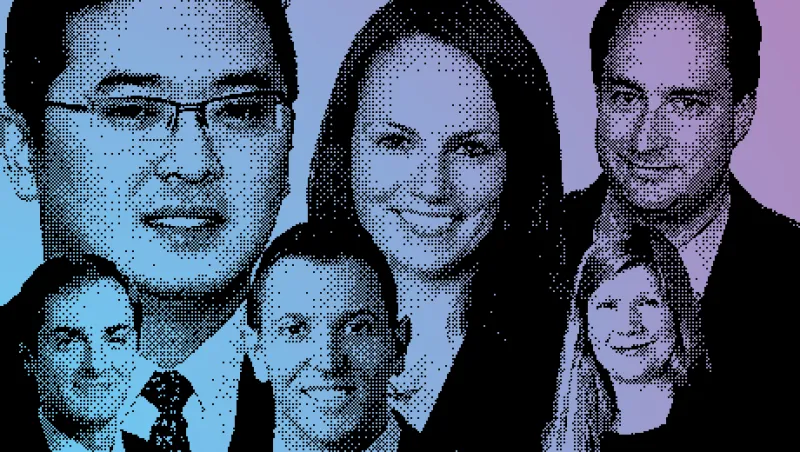Cameron Horwitz has been a senior equity researcher for nearly two years — and he’s only 28. After earning a bachelor’s degree in accounting and finance at the University of Miami, Horwitz worked as an associate analyst covering oil and gas exploration and production companies at several firms, including Canaccord Genuity and SunTrust Robinson Humphrey, until February 2012. That’s when U.S. Capital Advisors offered him the chance to direct the Houston-based outfit’s E&P coverage. Horwitz jumped at the chance.
“As an associate you are in a supporting role,” he observes. “I felt like I got the experience, I saw how the game worked, what it takes to be successful in the role — and I wanted the shot to do it myself.”
It looks like he made the right move. Each year when Institutional Investor asks buy-siders to indicate who among their sell-side counterparts warrants inclusion in the All-America Research Team, we also ask them to name the Rising Stars of Wall Street Research — analysts who have been publishing research for less than three years but have already attracted the interest of money managers — and Horwitz is among this year’s honorees. The Houston-based analyst acknowledges that the role of lead researcher is very different from that of an associate. “You get so enamored with working in your models and understanding the numbers, understanding the assets, but it’s a very fine balance because you have to sell those ideas,” he explains. “You have to strike a balance between that sales ability and the ability to understand the numbers.”
| Related ContentThe All-America Research Team Hall of FameOctober 7, 2013The All-AmericaResearch TeamOctober 8, 2013The All-America Sales TeamOctober 8, 2013The All-America Trading TeamOctober 8, 2013 |
Penwell describes the qualities he looks for when searching for new analysts: “Very intelligent people who are strong communicators. People who really want to dig, who know how to dig. Fast thinkers who can connect the dots quickly. People who are competitive, in the context of a team sport.”
One such person is Penwell’s colleague Jennifer Swanson Lowe, now making her second appearance as a Rising Star in Software.
“You can do a mathematical analysis, and you can come up with a point value for something, but ultimately behavior drives markets, changes in sentiment drive markets,” the 36-year-old says. “It’s a business where you need to understand what people are talking about, what the controversies are, what the debates are and how you can add value around those discussions.”
Lowe entered the industry on the sell side, as a junior analyst covering software and technology stocks at Raymond James & Associates, Piper Jaffray & Co. and Sanford C. Bernstein & Co., then moved to the buy side to report on tech stocks at AllianceBernstein. She switched back in 2009 to work with Adam Holt — a five-time member of the All-America Research Team (and three-time champion) in Software — and the following year launched her own coverage. She expanded her universe after Holt’s departure from Morgan Stanley earlier this year. (He moved to Qatalyst Partners, a San Francisco–based investment bank that focuses on technology companies.)
Having lived through not one but two market crises — the bursting of the dot-com bubble in 2000–’01 and the global meltdown of 2008 — Lowe has learned the keep the big picture in view. “If a company is a good story and it’s really inexpensive because of certain market conditions, you can’t focus on the short term and say, ‘The market’s down 50 percent, the stock’s down 50 percent, so I just can’t like it anymore,’” she contends. “You really have to take a step back with a medium- or longer-term outlook and ask, ‘What are the ideas that really have staying power and can come back over time?’”
One emerging theme that Lowe stresses is the development of software as a service, “as spending migrates away from infrastructure software, from hardware and other areas of technology,” she reports. The first wave was the introduction of applications — for example, customer relationship management tools — that require little customization. More recently, with the growing prominence of such companies as ServiceNow, an information technology management software developer headquartered in San Diego, and Pleasanton, California–based Workday, which provides big-data analytics and financial management services, “you’re starting to see the next class of applications moving into the cloud,” she says. “We’ve been paying attention to how quickly and whether some of these back-office-type applications are able to make the leap into the cloud. We think they will, and that’s potentially a very large opportunity over time.”
The most recent financial crisis has also taught Horwitz a thing or two. When he began covering E&P stocks in 2007, West Texas Intermediate crude was roughly $150 a barrel. The following year the price had plummeted to $30.
“When you’re in a more robust commodities price environment, the market is more likely to ascribe credit to things in a net-asset-value context,” he maintains. “But on the downside the market view can quickly flip, and you have more emphasis placed on cash flow multiples and balance sheet multiples. It certainly allowed me to have a better understanding of how the market is thinking of things in different parts of the cycle.”
In addition, that spectacular reversal “taught me a quick lesson on how capital-intensive this industry is — that if commodities prices turn against you and you’ve extended yourself beyond your means, how quickly that can have a negative effect on your balance sheet,” he notes. “That’s certainly affected how we’ve recommended stocks.”
Among the names Horwitz is currently urging clients to buy are Denver’s Cimarex Energy Co., Energen Corp. of Birmingham, Alabama, and Irving, Texas–based Pioneer Natural Resources Co., all of which should benefit from the production growth outlooks for the North American Permian Basin, a vast reserve that stretches from southeastern New Mexico into western Texas.
He also likes Gulfport Energy Corp., owing to its exposure to the Utica shale formation in the northeastern U.S. and southeastern Canada. The Oklahoma City–based outfit has wells that “are comparable on the gas side to some of the best wells that are being drilled in the Marcellus right now — which is some of the best productivity for gas wells in the country and probably in the world.”
The Great Recession has also informed the work of William Slabaugh, a Rising Star in the Restaurants sector. What the market has endured since 2008 “has made me more skeptical of what I hear from management teams,” the Stephens analyst asserts. “More important, it also made me more aware of relative valuations and the importance of a business’s true free-cash-flow generation capabilities, which I think are often forgotten in the restaurant industry.”
Thanks to an environment of high unemployment and anemic real gross domestic product growth, the Little Rock, Arkansas–based researcher says, “a lot of good restaurant businesses with strong brands and margin profiles were written off, such as Krispy Kreme Doughnuts and Sonic Corp. That gave me an opportunity to become more vocal on the positive side.”
The 29-year-old has been bullish on those two companies — headquartered in Winston-Salem, North Carolina, and Oklahoma City, respectively — for more than a year.
Slabaugh describes Krispy Kreme as “a broken company, but not a broken brand.” Previous management teams “had done a lot of things that had really hurt what was going on within the company,” he says. In 2008 board chairman James Morgan was appointed CEO, with a mandate to pull the chain store operator back on track. “A lot of things the new management team was doing were moving the company in the right direction,” the analyst says. “Now they have accelerating sales growth and accelerating unit growth.”
He believes Sonic presents a similar turnaround opportunity. The company, which operates more than 3,500 drive-through fast-food restaurants, is “an undervalued franchise that’s accelerating its sales growth.”
A graduate of the University of Arkansas with a double major in international business and Spanish, Slabaugh began his career in Stephens’ corporate finance department before moving into equity research. That firm, like many others, prefers to promote from within rather than pluck established analysts from competitors.
Michael Eastwood, director of Americas equity research at Jefferies in New York, shares that philosophy. “It’s really refreshing to hire associates because it’s all about talent rather than experience, and it’s good to be able to craft the sort of associate you want,” he explains. “It’s easier to take an associate, give them coverage under the umbrella of a successful analyst, carve out a relevant space, allow them to cover securities within a successful franchise and then, in due course, you’ll find them a greater opportunity.”
That approach also involves less uncertainty. “You’re choosing from a group of people you know,” Eastwood adds. “When we go outside to hire somebody, we don’t actually know them. We are taking views from clients, from consultants, from people that we know within the industry — but it’s a higher-risk strategy.”
Piper Jaffray’s Erinn Murphy, a Rising Star in Apparel, Footwear & Textiles, also began as an associate fresh out of college. “I would probably put myself as green as they come out of undergrad, in terms of understanding how the market works and understanding how the sell side works,” the 31-year-old says. “I would call the learning curve steep. For me, not coming from a finance background, it was baptism by fire.”
Over the next four years, the Houston-based analyst learned how to analyze balance sheets, conduct channel checks and observe how “everything fits together.” Then she took an unusual career detour, accepting a position as a natural-gas negotiator with Exxon Mobil Corp., a job that involved buying and selling gas for the company’s refineries.
Though unconventional on the surface, the move matched Murphy’s background. She grew up in the United Arab Emirates and Oman and is conversant in Arabic and French. Her expatriate childhood made her interested in a more internationally focused career, but she ended up returning to Piper after two years because she missed the markets and the creativity of the sell side. “What I was hoping at Exxon, which never panned out, was an opportunity to move back overseas,” she explains.
Back at the firm, Murphy worked as an associate for specialty-retailing analyst Jeffrey Klinefelter, then launched coverage of apparel and footwear companies in August 2012, carving out a piece of Klinefelter’s space when he was promoted to head of global equities. Her positive outlook for the fashion and lifestyle brands she covers centers on “premium brands with global footprints and strong market share positions” that can benefit from a nascent recovery in Europe and an expansion into Asia. Examples include footwear maker Deckers Outdoor Corp. of Goleta, California, and New York–based clothiers PVH Corp. and Ralph Lauren Corp.
Philip Ng, a Rising Star in Paper & Packaging, followed a different path to investment research. A graduate of the University of Michigan with a bachelor’s degree in economics and communication, Ng worked for several consulting firms in business valuation, but “it was very backward-looking,” he says. “Our clients were across industries, so I didn’t have any expertise in understanding any of these businesses.”
To gain more in-depth knowledge, Ng decided to move to equity research, first as a sell-side associate covering packaging companies at Lehman Brothers and Wachovia Securities, and then on the buy side at Bala Cynwyd, Pennsylvania–based Susquehanna International Group and Boyar Asset Management, a hedge fund headquartered in New York. He rejoined the sell side in 2010, when he was offered a lead analyst position at Jefferies.
The 35-year-old, who works out of New York, cites many positives about his newest post. “It’s more dynamic. It’s stock picking. It’s researching. It’s client facing. It’s more entrepreneurial.”
Ng is upbeat about his group’s prospects. “You’ve seen a lot of consolidation, and that’s translated into pricing power,” he reports. “Pricing goes straight to the bottom line, and most companies I cover generate a lot of free cash flow. They’ve been able to use that cash in a very astute fashion. We’re at a point where balance sheets are strong enough that you’re going to see a lot of cash being returned to shareholders.”
His recommendations include Memphis, Tennessee–based International Paper Co. and Rock-Tenn Co. of Norcross, Georgia. The latter’s 2011 acquisition of Smurfit-Stone Container Corp., one of the world’s largest containerboard recyclers, was a “transformative deal in the marketplace,” Ng declares.
Another analyst who cut his teeth as a consultant to companies in the sector he now covers is Leerink Swann’s David Larsen, a Rising Star in Health Care Technology & Distribution for a third straight year. Larsen, 42, spent more than a decade in the finance units of such outfits as Harvard-Pilgrim Health Care, Newton-Wellesley Hospital and UnitedHealth Group, then joined PricewaterhouseCoopers as a consultant advising providers on how to use technology to streamline operations and improve cash flow.
“I learned to really value high-quality, very clean IT infrastructures within these provider and health plan organizations because if you have good clean data, that’s how you run the business,” the Boston-based analyst explains. “I’ve used [Medical Information Technology], which is an IT vendor with one third of the hospital market. I’ve used Eclipsys [Corp.]. I’ve used Cerner [Corp.]. I’ve used a lot of these different systems that I cover.”
Larsen, who earned a degree in economics at Boston College and an MBA in health care management at Boston University, entered the world of sell-side research in 2005 when he joined SunTrust Robinson Humphrey as an associate tracking health care services stocks. He moved to Cowen and Co. and then, in 2009, to Leerink. The following year, Larsen was offered the opportunity to direct coverage of health care technology companies.
Equity research “always appealed to me because there’s a heavy math component to it,” he says. “Plus it’s a very dynamic, fun space to be in. I’m traveling all over the country, visiting with management teams and clients. It’s very interesting work, and the people in the field can be very smart.”
The analyst’s current top pick is Cerner. He believes the North Kansas City, Missouri–based company will benefit as both the Patient Protection and Affordable Care and Health Information Technology for Economic and Clinical Health acts prompt hospitals to migrate to one technology platform. “If all of the hospitals in an integrated delivery network are on the same technology platform, that can help the management of the health system better manage and coordinate care,” Larsen explains.
As this year’s team of Rising Stars attests, there’s no single road to success in sell-side equity research. “There’s talent everywhere, and we want to have a bigger pool of talent to draw from,” observes Morgan Stanley’s Penwell. “Over the last few years, we’ve been aggressive in trying to tap as many sources as possible because there’s good talent with great experience at a number of different places.” • •
Follow the 2013 All-America Research Team on Storify
Get more research and rankings.






